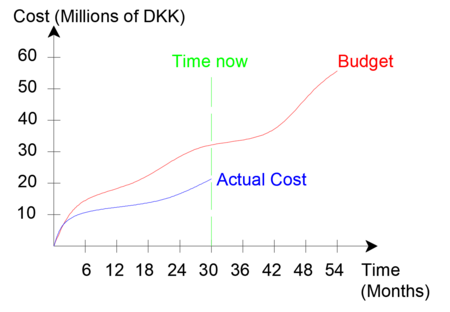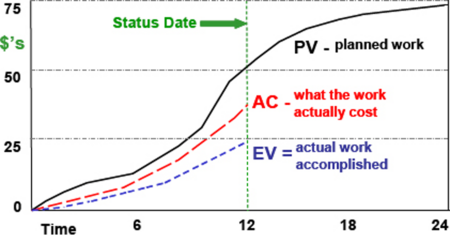Earned Value Management - EVM
Contents |
Abstract
Earned Value Management is a very powerful and popular project monitoring tool. Monitoring and controlling are key practices in project management, serving the purpose of informing the project managers on the advancement of the project. They take as inputs the results of the planning process and investigate if the plans are being implemented in an anticipated way. In this context, Earned Value Management is mainly used in highly complex environments like construction and infrastructure and allows for a combination of time and cost controlling (ISO 21500), therefore guaranteeing a more holistic overview of the project advancement than other monitoring tools.
This paper will firstly provide a description of the tool and its purpose including formulas and essential vocabulary. Then, it will provide a framework on how to apply this method. Lastly, it will look into its limitations, and explore the reasons why it is mainly used in very complex projects and environments [1]..
How to do Earned Value Management

“How is your project going?” is a very frequently asked question to project managers and one it’s not easy to answer. As pointed out by Lukas, Joseph A. [3] one of the techniques that are frequently in project management is comparing the planned expenditure curve with the actual one. However, this approach can cause major errors and provide misleading information. As projects are complex processes that involve a large number of aspects and dimensions, controlling just one of these dimensions is reductive. For example, in this case, it is not clear if the work is being accomplished with less money than anticipated, or if the project is behind schedule. The scope of earned value management is to provide a bi-dimensional tool, that is able to plot both the time and cost dimension of the project, therefore providing a more holistic monitoring tool that in one single graph contains a large amount of information on the project.
Terminology
As pointed out by Lukas, Joseph A. [4] it is important to clarify the terminology associated with Earned Value, as it is a source of confusion for many:
- Earned Value Analysis (EVA) — It is a quantitative method of assessing the progress of a project at any given point in time, predicting its completion date and final cost, and evaluating cost and schedule variances as the project progresses. Its objective is to assess whether the cost, schedule, and work done are progressing in accordance with the plan, comparing the expected amount of work done with what has actually been achieved. (Earned Value Analysis by Scott W. Cullen)
- Earned Value Management (EVM) is a project management methodology that uses an integrated schedule and budget approach and is based on a WBS to objectively evaluate project performance.
- Earned Value Management System (EVMS) — This is the method, processes, resources, and models that a company uses to implement Earned Value Management. The key is that Earned Value Analysis formulas can be used on any project, but if an Earned Value Management methodology is not in place, it would be highly unlikely to produce accurate results. Moreover, in order to implement Earned Value Management, there must be an Earned Value Management System in place. The three concepts are therefore very closely linked to each other.
Earned Value Analysis : How to

To carry out Earned Value Analysis, three key values need to be available: the planned value (PV), actual cost (AC), and earned value (EV). The first and second terms are the planned and actual expenditure cost, and should therefore be easy to obtain. The third term (earned value) is however more complicated to estimate as it measures the amount of value the actual activities completed have created. In detail:
• The Planned Value (PV) is the budget for the work to be achieved within a given period of time. The PMBOK Guide[6].
• Actual Cost (AC), is the cost incurred for the execution of project work, also known as actual expenditure. It can also be seen as the actual costs (AC) incurred to convert the planned value into the earned value [7]. It is also known as the Actual Cost of Work performed (ACWP). This value can be either calculated through a Cumulative approach or a Current approach. Cumulative AC is the total amount that was spent before a given time, while Current AC is referred to as an interval of time (days, weeks, months…). This is an important consideration as it is key to set regular data collection intervals (once a week, once a month, etc..).
• Earned Value (EV) is the ratio of the total authorized budget actually completed at a certain date. This is also regarded as the budgeted cost of work performed (BCWP). EV can be defined by multiplying the budget for a work package or activity by the percentage of advancement: EV = percent complete x budget. [8]
Application
Limitations
Annotated bibliography
References
- ↑ Fleming QW, Koppelman JM. Using earned value management. Cost Eng (Morgantown, West Virginia). 2002;44(9):32-36.
- ↑ Fleming QW, Koppelman JM. Using earned value management. Cost Eng (Morgantown, West Virginia). 2002;44(9):32-36.
- ↑ Lukas JA. How to make earned value work on your project. PMI® Glob Congr 2012—North Am Vancouver, Br Columbia, Canada. 2012;(5):1-9.
- ↑ Lukas JA. How to make earned value work on your project. PMI® Glob Congr 2012—North Am Vancouver, Br Columbia, Canada. 2012;(5):1-9.
- ↑ Fleming QW, Koppelman JM. Using earned value management. Cost Eng (Morgantown, West Virginia). 2002;44(9):32-36.
- ↑ PMBOK Guide
- ↑ Fleming QW, Koppelman JM. Using earned value management. Cost Eng (Morgantown, West Virginia). 2002;44(9):32-36.
- ↑ Lukas JA. How to make earned value work on your project. PMI® Glob Congr 2012—North Am Vancouver, Br Columbia, Canada. 2012;(5):1-9.